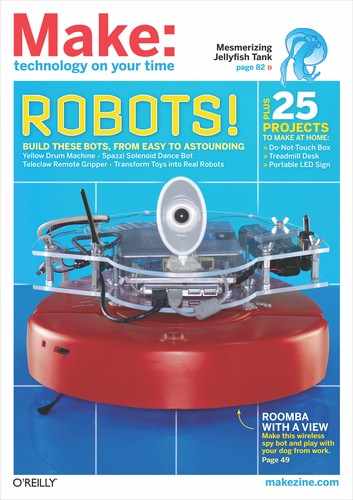WELCOME
Building Robots That Play
THIS MAY, MAKER FAIRE BAY AREA
brought together 100,000 people for a weekend to celebrate creativity, tinkering, and the DIY spirit. I’m proud to see our event grow so large in just six years. It’s a huge indicator that the maker movement continues to broaden by inviting more people to see themselves as makers. Maker Faire is a tremendous outpouring of creative energy: it comes from diverse sources, including very personal motivations, and it goes in all directions.
A reporter at Maker Faire asked me to point out “useful inventions” and “practical applications.” I had to think for a moment, but I replied that what dominates Maker Faire are things that are less practical and more playful. It’s like seeing the world through the eyes of a kid, where ordinary stuff like cardboard has all kinds of possibilities for playtime. The power lies in your imagination.
We tend to look at invention and innovation as serious business, causing us to miss the bigger picture. In 1876, a committee evaluating Alexander Graham Bell’s patent for the telephone dismissed the device as “impractical,” “idiotic,” “hardly more than a toy.” (My favorite reason was that there was no shortage of messenger boys.) We have a hard time predicting how technology creates new opportunities for people to enjoy life.
Robots were conceived as laborers, designed to do the boring, repetitive tasks that humans didn’t want to do. In a dystopian vision of the future, the machines rule because they do all the work and there’s really no need for humans.
But can a machine be playful? Can it entertain us, even mimic us? Indeed, most of the technology in our lives we use for play, and that play personalizes the technology, whether it’s cars or computers. I wonder how long it was before IBM recognized the popularity of solitaire on PCs.
Nothing could be more mundane than a robot that cleans house, as iRobot’s Roomba does. But ever since the debut of the robotic vacuum cleaner, hackers have treated it like a plaything. This issue’s “Roomba Recon” project (page 49) starts with a Roomba as a mobile platform, then adds wireless networking and a video camera to create a spy robot with all kinds of potential for mischief. Useful? Maybe. Fun? Definitely.
Our “Spazzi” bot (page 56) is a rhythmic response to the question, “So you think your robot can dance?” Developed by Marek Michalowski of BeatBots, Spazzi amuses us. Yet the thinking behind this toy robot reflects a serious application. BeatBots also developed the Keepon robot, a yellow ball that can produce a range of simple expressions for nonverbal interactions with children. Keepon has been used in studies of autistic children to understand how they react to social cues.
“Teaching Old Toys New Tricks” by DJ Sures (page 66) shows you how to use the Bluetooth EZ-B Robot Controller to transform a dopey Digger the Dog pull-toy into an autonomous robot that can chase a red ball and obey your voice commands. Someone will no doubt program Digger to chase cars as well.
The playful robots we feature in MAKE say a lot about us humans and how we create things in our own image. We’ve domesticated dogs to do things like play fetch, come when they’re called, and lie by our side while we sit in our favorite chair. Like dogs, robots are becoming our companions, demonstrating the ability to learn new routines that make us happy. ![]()
Dale Dougherty is the founder and publisher of MAKE.

